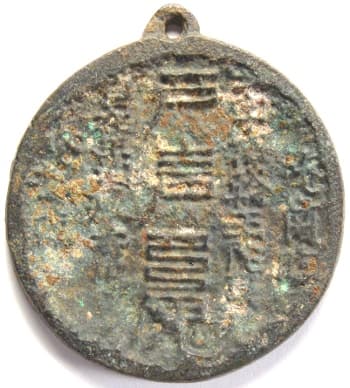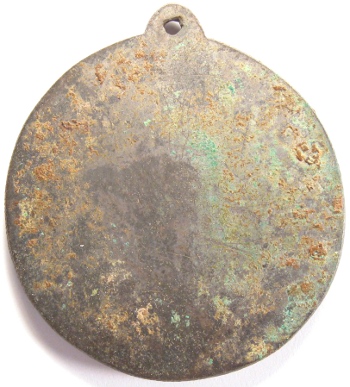Chinese bronze mirrors are usually circular with one side highly polished to provide a reflective surface and the other side decorated with an inscription and symbols.
Simple undecorated bronze mirrors first appeared during neolithic times while the earliest decorated mirror, which was discovered in a tomb in Qinghai Province, dates to the Xia Dynasty (2100-1600 BC).
In terms of quality and production, the period from the Warring States (475-221 BC) through the Tang Dynasty (618-907 AD) was the heyday of Chinese bronze mirrors. By the middle of the Qing (Ch’ing) Dynasty (1644-1911 AD), bronze mirrors began to be replaced by glass mirrors and the 4,000 year history of bronze mirror use was nearing its end.
Chinese bronze mirrors were primarily used for vanity purposes but were also used to start fires by concentrating sunlight.
However, mirrors were also used for ritual and spiritual purposes.

This is an example of an old Chinese Daoist (Taoist) mirror.
The inscription is written in Daoist “magic writing” (fuwen 符文) and its meaning can only be understood by a Daoist priest.
Mirrors were believed to have strong amuletic powers that could ward off evil spirits. An invisible demon would flee when it saw its reflection in a mirror.
For this reason, Daoists often wore these mirrors hanging down the back to protect against being blind-sided by a ghost.
These mirrors were also hung in traditional Chinese houses in order to scare away evil spirits.
So even though the exact meaning of the inscription on the mirror is unknown, we can reasonably believe that it is meant to provide protection from demons.

Reflective side of Daoist mirror
This is the “reflective” side of the mirror.
Since it is believed that this mirror was used to provide protection, the mirror was probably hung with the inscription side facing outwards.
Mirrors used for this purpose frequently had concave surfaces. This mirror is actually concave on its inscription side. A concave mirror “inverts” the image of a ghost, and thus “overturns” any evil influences.
Daoist priests also used the concave bronze mirrors to collect dew which, because of its “purity”, was used in rituals.
This talisman mirror with Daoist magic script characters was probably cast during the Qing Dynasty and is actually quite small. It has a width of 5.3 cm and a weight of 37.6 grams.
Hi Gary,
While searching the net for a “Chinese antiquities expert” I found your site, and was impressed with your knowledge and expertise. I am hoping you can help me solve the mystery of a bronze “Amulet”? I have…It has been suggested that it could be a Daoist priest’s exorcism mirror with seal script inscription’s…you will probably know better…I apologize in anticipation for this intrusion on your time. PS, I can provide photos if you are able to help, to an email address or through whatsapp.
kindest regards,
lesley Rimmer